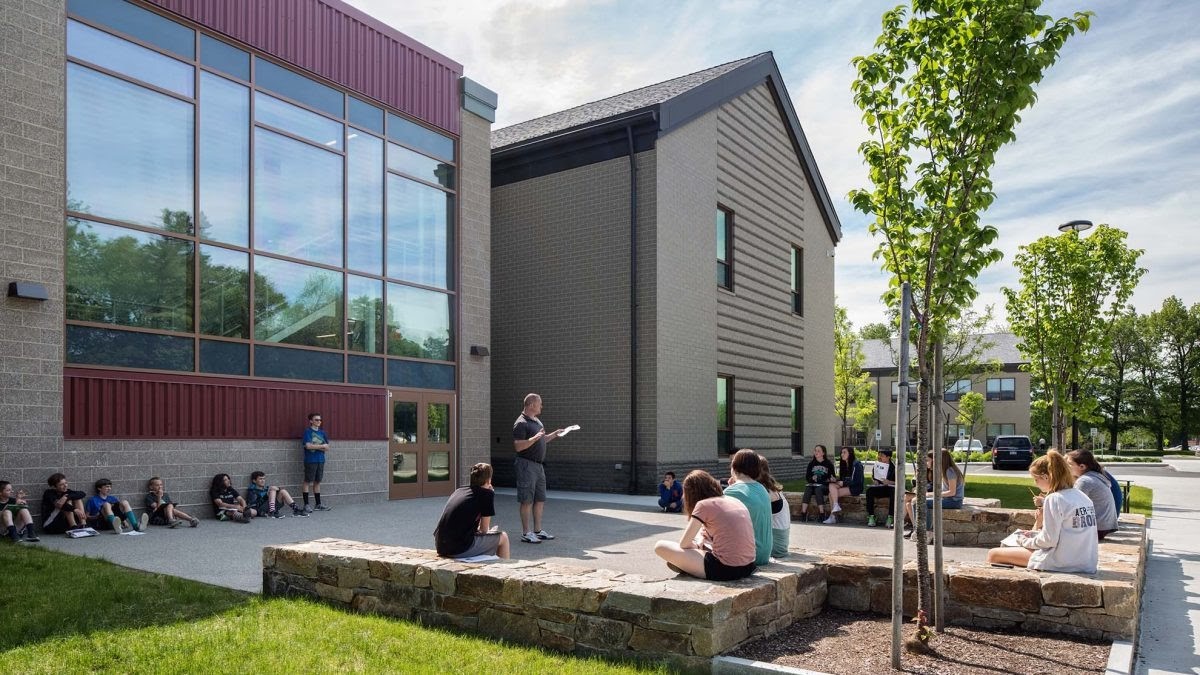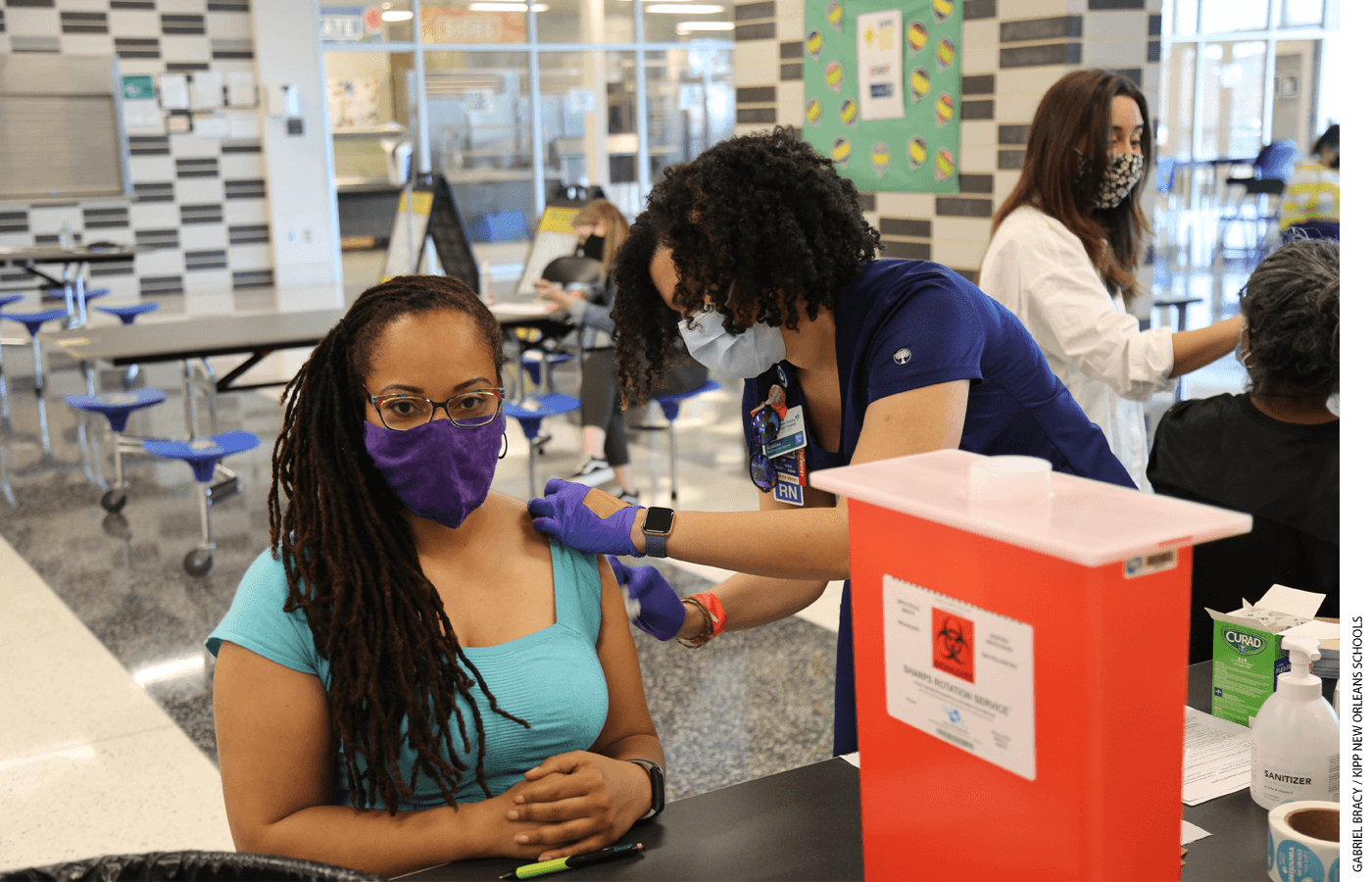

By Emme Luck | Thu, March 25, 21
As Healthy Schools Day approaches, we are reflecting upon the importance of healthy learning environments and the ways in which we create holistic and productive spaces for our youngest community members. Healthy Schools Day is intended to build public awareness and support for the consideration of health in school design and maintenance.
You may be wondering how healthy schools fit into NEEP’s work. Efficient schools offer a multitude of interwoven health and resilience benefits, like increased indoor air quality and the ability to safely shelter in place. Many of these have been highlighted by the COVID-19 pandemic. This intersection of energy efficiency, health, and resilience is present in many aspects of our daily lives and often goes unnoticed. At a high level, the efficient use of energy resources prolongs the lifespan of these resources and is less taxing on our buildings and our energy systems. Reduced need for generation reduces the emission of greenhouse gases and toxic chemicals and increases system reliability. In schools, energy efficiency measures in HVAC systems can translate to reduced rates of asthma and other respiratory issues by maintaining healthy indoor air quality and increased productivity thanks to more comfortable environments. Moreover, extreme weather events, and now pandemics, are teaching us the value of resilience and the ability to shelter in place. As essential components of a community ecosystem and spaces that shape future generations, schools must be equipped to weather these storms.
Healthy Schools as Community Centerpieces
Schools, as the centerpieces of communities, are integral to achieving NEEP’s vision to transform the region's homes, buildings, and communities into efficient, affordable, low-carbon, resilient places to live, work, and play. Since 2002, NEEP has led a regional initiative focused on improving the health and energy efficiency of school facilities. These efforts focus on regional collaboration and engagement to understand the challenges and opportunities that schools stakeholders are facing. This regional peer-exchange network propelled the development of the Northeast Collaborative for High Performance Schools (NE-CHPS) criteria, several in-person conferences, and an online resource library. NEEP continues to manage NE-CHPS on behalf of this regional network to ensure it is updated regularly and accordingly with regard to the climate and educational priorities of the Northeast region. Additionally, NEEP works directly with many school districts to provide assistance on their project goals, and has catalogued many of these best practices in the Zero Energy Schools Toolkit.
NE-CHPS, first established in 2006, was the first building design criteria specifically aimed at school facilities. The goal of the criteria was to catalogue best practices to ensure that all students and staff had access to healthy, energy-efficient, and productive learning environments. It was developed with input from regional stakeholders, including architects, engineers, state agencies, and departments of education from across the region, to mirror the climate, building codes, and educational priorities of the Northeast. It is used by design teams and school districts as a standard for school construction. NE-CHPS is currently used in state-run school building programs in New Hampshire, New York, Massachusetts, and Rhode Island.
NE-CHPS: What’s New and Different?
This year, NEEP is celebrating Healthy Schools Day by updating NE-CHPS from version 3.2 to version 4.0, which entails significant upgrades to sections including: Zero Net Energy Capable, Biophilic & Responsive Design, Safer Schools By Design, and Low Radon. It also includes a brand new section: Design for Adaptation & Resilience, adapted from US-CHPS. The update also includes minor upgrades such as the update of standards from IECC 2015 to IECC 2018 and from ASHRAE 62.1 and 90.1 from 2016 to 2019, the removal of the operations report card, and more linked resources and other references.
The intent of the new Design for Adaptation & Resilience section is to encourage practices that plan for changing climate conditions over the building lifespan and create schools to serve as sustainable centers of community resilience. Climate change is already contributing to increased overheating and other extreme weather disasters at schools, events that are expected to worsen over the next century. This NE-CHPS criterion outlines components including a climate vulnerability assessment, adaptation and resilience measures, and passive habitability characteristics in order to ensure the long-term durability of a school.
To further enable community decarbonization, the Zero Net Energy Capable section provides a whole new compliance pathway modeled after the Massachusetts Energy Zero (MA EZ) Code, recently developed by NEEP to support the state’s goals. One school district is already planning to use the MA EZ code to build a net zero energy school.
We updated the Biophilic & Responsive Design section to reflect language from US-CHPS that addresses design elements promoting a sense of calmness and well-being. This is the purpose of responsive design: to create safe and calming spaces that contribute to a sense of community, and to allow for students of all abilities, backgrounds, and perspectives to learn together. The section was further updated to describe how breaking down barriers between the natural world and our indoor spaces can improve focus, awareness, social interactions, and a sense of wellbeing.
The previously titled Crime Prevention Through Environmental Design section was renamed Safer Schools By Design and the entire section was rewritten to shift emphasis from phrases like “deterring crime” and “reducing fear” to phrases like “increasing visibility” and “fostering a sense of safety.” This simple shift in language to adopt a more positive tone works towards achieving the goal of creating more connected communities. Updated elements of this criterion focus on themes of openness and transparency in the maintenance and use of school spaces.
The new Low Radon section includes more detailed guidance for new and existing schools to build and retrofit with radon-reducing materials and testing practices. It also provides more context around the negative health impacts of radon exposure and its presence in schools: radon is a human lung carcinogen and is the largest source of radiation exposure and risk to the public, as well as the second leading cause of lung cancer. Before presenting solutions guidance, it explains that approximately 20 percent of schools have high radon and about 41 percent of those schools are located in known high-radon areas. It is important to note the social factors that influence health risks like radon exposure. Studies have found that radon exposure may present significant risks to racial minorities and that rates of radon mitigation efforts reflect income and housing disparities. We have upgraded all of these sections, and more, to support the health and safety of students and community members at this critical time.
Living through a global pandemic has heightened the need for safe and healthy spaces. As we reflect upon the past year with an eye towards reimagined learning spaces, remote and hybrid teaching practices, COVID-19 protocols and canceled activities, and the use of schools as testing and vaccination sites, it’s hard to ignore the importance of creating and maintaining healthy spaces to live, work, learn, and play.
To celebrate Healthy Schools Day with us, check out our resources below and stay tuned for NE-CHPS version 4.0 to be released on April 6. In addition to the Zero Energy Schools Toolkit, NEEP displays High Performance School Exemplars and COVID-19 Operating Guidance for Schools; be sure to check our schools webpage for regular resource updates.



